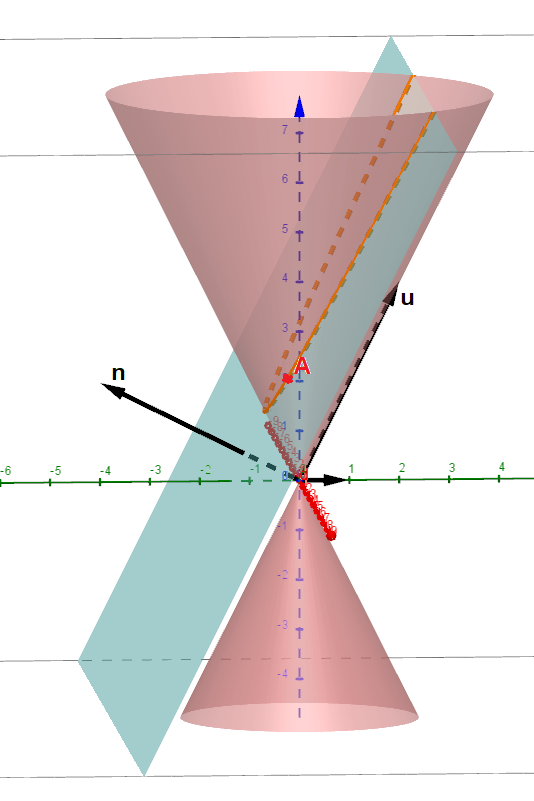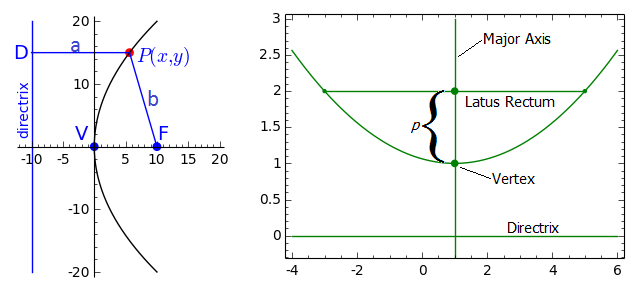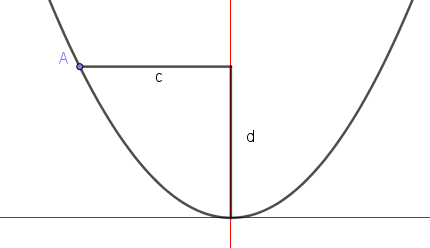Parabola

You probably know that a parabola is one of the possible slices through a double cone. Assuming the cone is circular then the plane containing the parabola must be exactly at the angle of the cone edge. In figure 1 direction vector $\mathbf{u}$ is obtain from some point on the cone and the cone origin. Vector $\boldsymbol{\mathsf{n}}$ is normal to $\mathbf{u}$ and also in a plane that contains $\mathbf{u}$ and the center axis of the cone. There is an infinity of normal vectors to $\mathbf{u.}$ We have to select the correct normal. Now we can select some point, $A$, almost anywhere on the cone and create a plane parallel to $\mathbf{u}$ which passes through point $A$. The intersection of the cone and that plane will be a parabola. The exception in selecting point $A$ is that it cannot be anywhere on the line created by the cone origin and vector $\mathbf{u}$, as that will produce a degeneracy.
Basics - Parabola
Previously, in discussing the conics, we have used $a$, $b$, and $c$ to mean the semi-major axis, semi-minor axis, and focal lengths. Now we are changing.
The quadratic equation of a parabola is $y=ax^{2}+bx+c$. The discriminant $(b^{2}-4ac)$ can be positive, negative, or zero, and we still get a parabola. If $a=0$, the curve degenerates into a straight line, but that is the only thing that will stop it from being a parabola. When $a$ is negative, it opens down and when $a$ is positive, it opens up. If we interchange $x$ and $y$ it goes side to side.
Switch back to the general conic equation form. $$Ax^{2}+Bxy+Cy^{2}+Dx+Ey+F=0.$$ Recall that in this general form, for the equation to be a parabola, $$B^{2}-4AC=0 \tag{1} \label{1}$$ and one or both of $D$ and $E$ must exist. If $\eqref{1}$ is less than zero, the conic is an ellipse. More than zero and it is a hyperbola. If both $D$ and $E$ are zero, and the discriminant is also zero, then the equation becomes $$Ax^{2}+Bxy+\left(\frac{B^{2}}{4A}\right)y^{2}=-F \tag{2} \label{2}$$ At a quick glance you might think that Equation $\eqref{2}$ is a parabola. Every parabola has this form where the coefficient of the $y^{2}$ term is dependent on $A$ and $B$. (Or vice versa, $\frac{B^{2}}{4C}x^{2}+Bxy+Cy^{2}\ldots)$ However, that means that the first three terms of any parabola can always be factored, so if there is not an additional x or y term, $$\frac{\left(2Ax+By\right)^{2}}{4A}=-F$$ then it will either graph as a line $(F=0)$, two parallel lines $(A\cdot F>0)$, or yield complex values which cannot be shown on a real number graph.
Parabola Nomenclature

Define the parabola as a 2-dimensional curve where every point on the curve is equidistant from a point known as the focus and also equal distance from a line known as the directrix. The directrix, labelled in Fig 2 is the same distance from the vertex, $V$, as is the focus, $F$. That distance is, by convention, labelled $p$. Since it is a distance, $p$ is positive. In fact, when calculating $p$ it may compute to a negative value. When it does, that suggest that the parabola opens downward.
Vertex of a Parabola
TLDR Version: Put the vertical equation into the form $y=ax^{2}+bx+c$. The vertex $x$ coordinate, called $h$, is $h=-b/(2a)$. Substitute $h$ for $x$ in the equation and calculate $y$. That value is $k$. Finally, $p=1/(4a)$. To finish write $(x-h)^{2}=4p(y-k)$. The Focus is $F=(h,k+p)$. The directrix is $y=p-k$. Done.
To find the vertex of a parabola from the equation, first assure that there is no $xy$ term. If there is, the parabola is rotated and needs to be realigned with the axes to remove the $xy$ term. Once we have a simple parabola equation, we can find the vertex by either completing the square or by minimizing the derivative of the squared variable. I prefer the later method.
Here are two quick examples of finding the vertex from the derivative.
Answer: There is no $xy$ term so just get $df/dx=0$ and solve for $x$. $$2x-8=0\quad\Longrightarrow x=4$$ Now put $x=4$ into the parabola equation to get $y$. $$(4)^{2}-8(4)+2y=-13$$ $$2y=-13-16+32=3$$ $$y=\frac{3}{2}$$ So the Vertex is $V=(4,3/2)$.
Answer: There is no $xy$ term and the squared variable is $y$, meaning the parabola is on its side. Set $df/dy=0$. $$2y-8=0\quad\Longrightarrow y=4.$$ Now put $y=4$ into the parabola equation to get $x$. $$(4)^{2}-2x-8(4)=-19.$$ $$-2x=-19-16+32=-3$$ $$x=\frac{3}{2}.$$ So the Vertex is $V=(3/2,4)$.
Answer: $$\left(y-\frac{8}{2}\right)^{2}=2x-19+\left(\frac{-8}{2}\right)^{2}$$ $$\left(y-4\right)^{2}=2x-3$$ $$\left(y-4\right)^{2}=2\left(x-\frac{3}{2}\right)$$ This method for finding the vertex potentially has an advantage in that the form indirectly yields the distance from the vertex to the focus.
Focal Length of a Parabola
Assume a vertical, “open-up” parabola and let's make its vertex $(h,k)$. Then, its Cartesian equation is $4p(y-k)=(x-h)^{2}$ where $p$ is the focal length, i.e. the distance from the vertex to the focus. By algebra, we can arrange to get that form and then use the coefficient in front of the $(y-k)$ term to calculate $p$. For a verical parabola, that is often the best way to obtain $p$. Although $p$ is a distance, and distances are positive, it can turn out that completing the square will obtain a negative $p$ value. Let it be! A negative $p$ not only tells us that the parabola is "open-down" but additionally permits the same equation to be used for the focus and directrix. The focus is $(V_x,V_y+p)$ and the directrix is $y=V_y-p$.
Another Way to get $p$, is from a chord. We construct a chord of length, $c$ from nearly any point on the parabola perpendicular to the symmetry axis. To do that, we must know the equation of the symmetry axis. If we let $(h,k)=(0,0)$,then the parabola equation is $4py=x^{2}$. Let $d=$distance from the vertex to the chord going along the line of symmetry.

With this setup, the coordinates of $A$ are $(-c,d)$ and since $A$ is a point on the line we can substitute into the parabola equation. $$4pd=(-c)^{2}$$ Solving for $p: p=\frac{c^{2}}{4d}$. Since we are dealing only with lengths, $p,c,$ and $d$, this method will work to find $p$ from any parabola, rotated in any direction or not. There is still some work to find $p$ this way, since we have to establish the line of symmetry and then construct a perpendicular to it from point $A$ and then compute distances, $c$ and $d$. We will show yet a third way to find $p$ when using parametric parabolas.